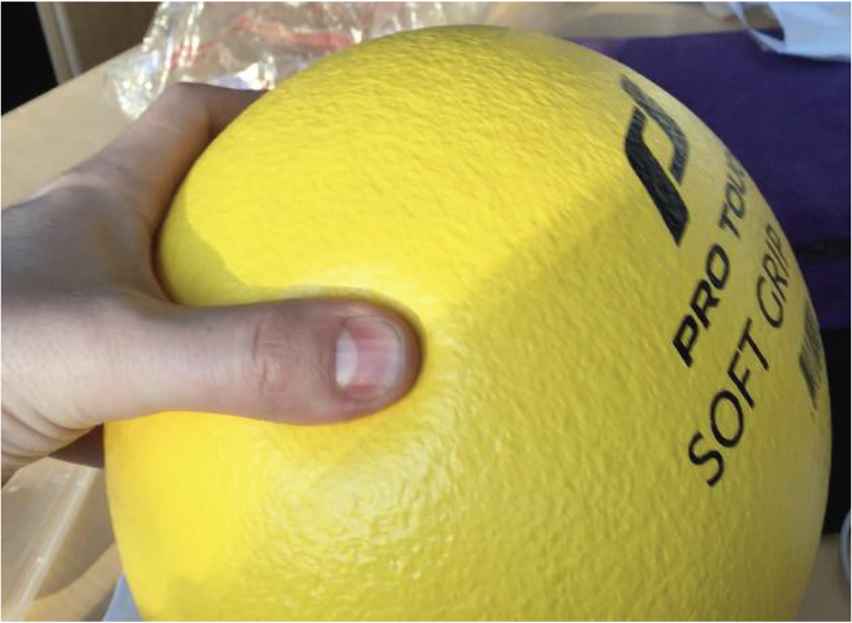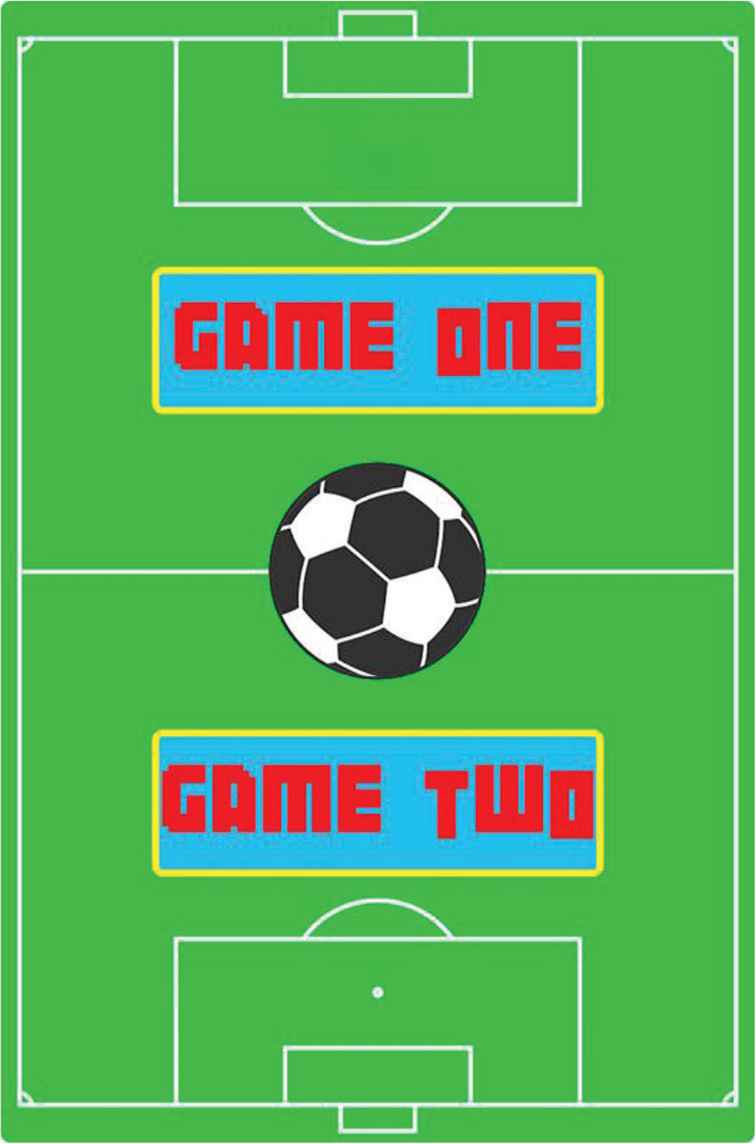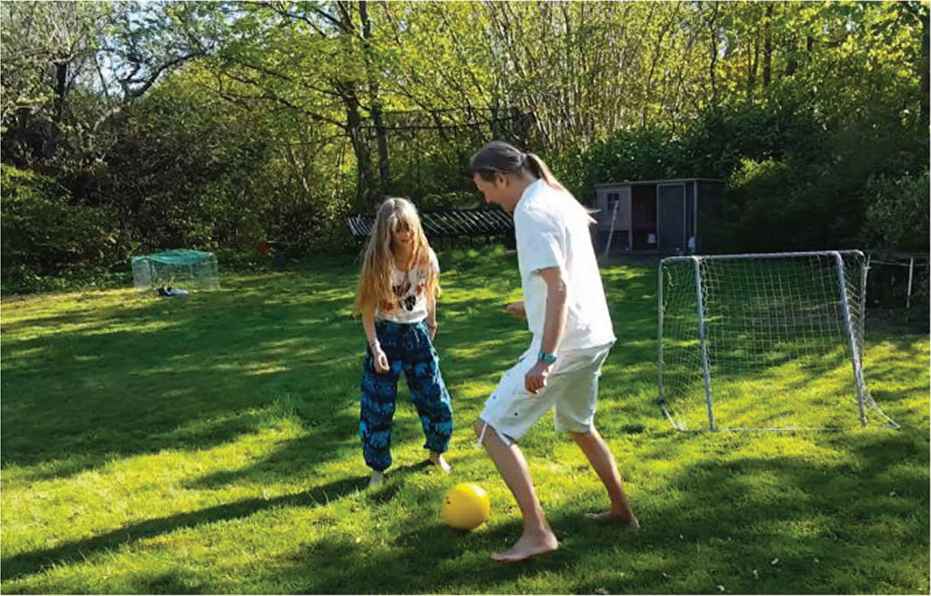Playware Ball – Development of an Intelligent Ball
- DOI
- 10.2991/jrnal.k.201215.001How to use a DOI?
- Keywords
- Playful technology; playware; personal health technology; adaptive games; football
- Abstract
For developing a novel kind of entertaining football and football training, we developed a playware ball prototype. The ball contains a microprocessor with WiFi connection and uses barometric pressure sensors and accelerometer data to track the ball movement in fast-paced football training games. The ball communicates with a tablet, on which games were developed that used the tracking of both skill level and the level of activity of the users. This kind of playware should motivate the users to play and have fun with the interactive ball. The initial findings indicate that the sensor fusion of barometric pressure data and accelerometer data proves reliable in the fast-paced setting of football games. Furthermore, the constructed prototype foam exercise ball proved a reliable container to house both the sensor and computational devices in a safe manner and could be useful for further tests on other aspects of combining gaming and physical exercise.
- Copyright
- © 2020 The Authors. Published by Atlantis Press B.V.
- Open Access
- This is an open access article distributed under the CC BY-NC 4.0 license (http://creativecommons.org/licenses/by-nc/4.0/).
1. INTRODUCTION
Over the last two decades, playware has been developed as a fruitful field of research and development of intelligent hardware and software that produces play and playful experiences for users of all ages [1–4]. Playware is often instantiated as physical objects that users interact with. The playware object comprises processing and communication power, which by the appropriate processing and active response on the user interaction, can mediate a playful interaction. With the response, the playware object acts as a play force, which pushes the users into a play dynamics – if the response is designed in a manner that motivates the user to perform actions. Often, if intrinsic motivation to interact with the playware can be found in the user, the response and play dynamics will be strong and long-lasting. Intrinsic motivation is defined as performing an action or behavior due to the enjoyment of the activity itself. According to Ryan and Deci [5], intrinsic motivation is the doing of an activity for its inherent satisfaction rather than for some separable consequence. When intrinsically motivated, a person is moved to act for the fun or challenge entailed rather than because of external products, pressures, or rewards.
In the search for methods to trigger people to become active, e.g. to prevent a sedentary lifestyle, it is therefore of special interest to look into activities which are known to intrinsically motivate a large proportion of people, like e.g. sports and music. Here we will look especially at football (soccer), as this is the most popular sport globally with over 4 billion followers of football, and since we see that football and other ball games trigger a passionate response in many people of all ages, cultures, and abilities. Indeed, ball play has traversed history, and ball games are known from early Mesopotamian, Egyptian, Greek, and Mayan civilizations [6]. Archeologists have found rubber balls dating back to 1600 B.C. as well as terra cotta figurines of ulama players from around 1200 B.C. Interestingly, for the game of ulama, the Mayans had developed a fairly reliable process, e.g. for stabilizing rubber, for the creation and production of the ball.
Today, we are able to use technological advances to create novel kinds of balls for ball games. In our effort to create a playware ball, we used the concept of Playware ABC [7–9] to develop the playware that can be used by anybody, anywhere, anytime, by building bodies and brains, which facilitates that people can construct, combine and create with the playware. This should allow for a development of a hardware, which is versatile and able to be used in many contexts and with different kinds of users at different levels. Hence, such a playware ball should be able to be used for leisure purposes, sports purposes, rehabilitation purposes, etc.
The playware ball was developed as a semi-autonomous robotic toy that could be self-explanatory in its intended use and that would require little to no instructions before being adopted. As a way to measure the activity and skill level of the users of the toy ball, the ball was equipped with a barometric pressure sensor and an accelerometer to provide reliable data for performing adequate movement analysis. The robotic exercise ball was developed to be expressive and fun. It was not developed using any specific expressive robotic models but analyzing it after its constructions phase using the model of affective expression modalities (MOAM) results in a point distribution of 3 for the sound modality which provides a coordinated effort to respond to user input [10].
The playware ball was preliminarily tested under different context circumstances to investigate how well the sensor combination of barometric pressure sensors and accelerometer sensors functioned with different pressure changes and different types of user handling. The form factor and sensor choice for the exercise tool proved a sensible combination usable for a large variety of purposes.
2. PHYSICAL CONSTRUCTION AND SOFTWARE SETUP
The physical object was a 20 cm diameter, foam-body, semi-autonomous exercise ball. The outer layer of foam was selected for the following main reasons:
- •
It contained a penetrable surface that allowed air to travel freely to and from the barometric sensor so that it would provide robust readings.
- •
The foam protected the sensors in a flexible enclosure.
- •
The elastic body of the foam enclosure worked as a shock absorber to prevent damage as the ball would receive hard kicks during exercise games.
- •
The foam ball invited energetic activities as its morphology would resemble a non-harmful toy that you were not afraid of kicking around with the risk of hitting indoor furniture or other people in the vicinity.
Inside the foam outer layer was a small embedded computer platform. The main system on a chip was an ESP8266 based platform with onboard WiFi to provide connectivity and data transfer to and from a mobile application. To the system on a chip (SOC), the accelerometer and barometric pressure sensor were attached. To facilitate communication with the Arduino based ESP8266 platform, the I2C communication protocol was used for both sensors. To power the device a dual cell lithium-ion battery was used. Sufficient charging ports were added to allow a swift and easy charging process between the exercise games. The constructed morphology aimed to entice physical activity and to present the hardware in a reliable package. Figure 1 shows the complete form factor of the exercise ball.

The playware ball containing the electronics inside.
The sensor processing and game initiation controls were controlled by a companion mobile application. The game would connect to the ball via a shared WiFi connection and would receive sensor data with a refresh rate of 200 Hz. The refresh rate was chosen as the best compromise between low granularity of sensor measurements and high power consumption for both transmitting the data as well as post-processing the data on a mobile device. Figure 2 shows the application’s main window and activity selection screen. To make sure the height estimations were as accurate as possible, the game would auto-calibrate the height measurement base of the barometric pressure at the start of each physical activity game. The software would assume that the ball was placed on the ground as the game was initiated to establish the lowest possible readings within each game.

The interface on the tablet when for selecting between the games with the playware ball.
To process the data the following post-processing filters were applied to the stream of incoming data. All data points were averaged, and the current height estimation was only affected through a low pass filter with high perseverance of the existing value. To focus the data measurements and filter unnecessary readings from the stream, the accelerometer data was used to detect when the ball was kicked and when the ball was descending toward the ground with detected expected gravity speeds. The accelerometer data was also used to detect when people kicked the ball and whether the ball was moving or was kept still. The audio-based expression modality of the physical setup was also provided through the app and the audio would automatically select speaker mode and increase the volume to ensure the users could hear the intended audio cue throughout the exercise sessions.
3. FUN IN THE GAME
The games developed for the exercise ball was created with the intention of being easily understandable, fun to play and also fun to watch. The aim was to make the games explainable in a single sentence to ensure the users could maintain a flow in the exercise routines by avoiding that anyone would stop in the middle of an exercise confused by the rules of the game. The games were challenging and fun as a means to keep the users coming back for repeated exercise sessions. The reason for making the games entertaining to watch as well was done in an effort to entice new players to join in.
From a health perspective, the games focused on two different types of activities with an emphasis on different body aspects to strengthen:
- •
The cardiovascular system.
- •
The fine muscle movement and eye-leg coordination.
The first game, which emphasized cardio strengthening exercises, was a game that enticed the participants to keep moving at a steady pace throughout the exercise session. The premise of the game was that the exercise ball would sense whether it was moving or standing still and communicated those different states to the users through each exercise session. To force the users to move during the game, the software would also keep track of each time the ball was kicked sufficiently hard. A hard kick meant that the users would have to chase after the ball and prompt further cardio strengthening activities. If a certain playing time had passed with no one kicking the ball (e.g. 4 s), the ball would play an explosion sound to convey that the game had ended. The premise was to keep the ball moving for as long as possible. High-scores would be gained if you could top the previous players’ overall exercise time.
The second game attempted to improve the finer muscle movements in the user’s legs and to strengthen the eye to leg coordination. The premise and goal of the game was to keep the ball in the air as much time as possible and avoid it hitting the ground. The sensors would register whether the ball was kept still, to make sure the users were not resting the ball on their feet during an exercise session. The barometric pressure was used to ensure that the ball would not stay beneath a threshold user-adjustable height for too long. If that happened, a sound would convey to the user that the game had ended.
4. PROTOTYPE VERIFICATION
The developed prototype hardware and game software were tested by five faculty staff members of the playware lab at the Technical University of Denmark. The preliminary tests of the foam ball indicated that the users often accidentally stepped directly on the critical center parts of the construction. To ensure this part would work in extended exercise sessions we attempted to perform tests where we put some physical strain on the equipment. This included the following tests:
- •
Hard-kick tests, in which we performed multiple subsequent hard kicks directly aimed at the center mass of the ball where the electronics were housed.
- •
Step-on tests, in which we stepped on the ball from several approaching angles.
- •
Drop tests, in which we dropped the ball from different high altitudes between first to the third floor of the university building.
It was important to make sure the ball would work across several different contexts. The final product was aimed at working both outside and inside, in high humidity, and warm and cold weather. The foam enclosure needed for the barometric pressure sensor to work excluded the construction from working in scenarios where it would get wet so it was only tested in dry conditions. To ensure the barometric sensor worked in less than ideal conditions, we attempted to introduce some sensor noise to occlude the sensor data during test exercise games. This included changing the local pressure in the room by opening a window during a game session and by moving the ball while it was calibrating the low height measure during game initiation. Different heights were tested and a different pace of height changes was tested to investigate the limits of these sensors in this specific setting.
Overall the combination of barometric pressure and accelerometer sensor data worked very well to determine the different states needed in the exercise games. They determined the altitude and movement amount with a high enough confidence level to be usable even in this fast-paced exercise context. The sensors often showed some erratic behavior where it would return outlier data such as jumping to a very high or low altitude level during the games but using basic filtering methods these wrong measurements were easily discarded. Once in a while, the local pressure would change in a given room. This changed the minimum height threshold defined in the game. By changing the calibration to occur at the start of each game we countered this effect with some success. However, this required the users to keep the ball still at the ground at the start of each game, which sometimes proved difficult as the test users had a hard time leaving the ball alone. We see that as a positive indication that the chosen morphology invites physical interaction.
Full game testing was performed in single- and multi-player mode for the second game of juggling the ball in the air, and for the first game of keeping the ball rolling, both indoor and outdoor – see Figure 3.

Two players testing the first game, in which one player has to keep the ball ‘alive’ (moving), and the other player has to make the ball stop for a small period of time, e.g. 4 s.
5. DISCUSSION - IMPROVEMENTS
Our testing phase showed that the next prototype could benefit from including more onboard expressive features. This includes both more expressive features used mid-game and also pre-game explanations and during game selection. Although the mobile application is a great platform to deliver written instructions and to provide processing power to analyze the sensor data, using it subtracts from the experience of having an intelligent ball that works alone without the need for tethered connections.
The expressive sound used throughout the exercise games makes the ball seem alive and should be coming from the ball, not the app. It was a clear indication through the tests that the users wanted to forget the app and just focus on the ball. This resulted in users kicking the ball to a distance about ten meters from the app, at which point it proved difficult for the data connection to remain active and which also made it difficult for the users to hear any game-related audio cues coming from the app. Moving to a standalone platform in the ball would also make it easier for people to interpret the exercise ball in an anthropomorphic way which might improve how people interacted with it. If people would see it as a viable partner during the exercises it could make them more eager to exercise alone with the ball. However, moving the electronics and adding necessary processing power to facilitate a standalone decide might be difficult as doing so will be a tradeoff between having the robustness and reliability of using simple electronics inside the ball vs using a more complex setup using powered speakers and more processing.
In the preliminary testing phase, there was a tendency for people to view the playware ball as an intelligent entity (e.g. some people expressed that the ball tried to trick them). This anthropomorphic interpretation may be utilized in further prototypes. This could maybe amount to making the ball laugh when people kick it or otherwise taunt them to interact with it. The responsive nature of the interactive exercise ball seemed to fit the scenario of enticing exercise well and it made people see the ball as a tool that was both energetic and alive.
Further improvements in future prototypes might also benefit from including better haptic feedback to the users. This is needed to make the ball an untethered standalone device. The haptic feedback could provide a way to provide feedback when the users initiate games or attempt to stop current activities. E.g. it might vibrate to give feedback or the users could shake it to change activity. Our current knowledge from developing this and other playware devices tell us the more simplistic we make the device, the more it will entice people to use it.
Using an app with the ball might also make people scared of trying it as the mobile device itself represents high levels of complexity and demands a steep learning curve from people who are not already familiar with smart devices. However, using the mobile platform has the advantage that the game can present visual cues and instructions to the users. Switching to a non-tethered ball could make it harder to convey the various game mechanics. It demands that the users are able to distinguish the different game rules and actions using audio cues alone, which could be difficult for new players and near impossible for the hearing impaired. As a result, these considerations should influence the design phase of future potential prototypes. They function as strict guidelines to enforce the simplicity in the design of playware games. If the tasks, goals and rulesets are kept simple, a non-tethered setup would be applicable in a much wider domain and could be introduced to a much wider audience with no previous experience in using smart technology. Discarding the tablet from the setup would allow potential user to skip the steep learning curve phase of getting familiar with mobile devices.
In development phases for new technology, we cannot per default assume that everybody (including the elderly generation) is comfortable with using mobile platforms or computers. Our preliminary testing shows that simplicity might be a viable way to appeal to a large variety of ages - when combined with a device that resembles a common object such as a football it makes it easy for new users to approach and start using it.
6. CONCLUSION
The sensors and the hardware proved reliable during our preliminary testing phases. The playware ball itself was a successful prototype that gave us knowledge on the type of material and enclosure needed to proceed in building further prototypes. The morphology proved enticing for people to pick up and start using and the expressive nature of the audio cues was interpreted as fun and informative during the exercise games. This was a preliminary investigation into the development of an intelligent piece of a playware exercise equipment to facilitate more enjoyable physical activities for the elderly generation and as such the prototype accomplished a lot with simple sensors in a complex scenario. The prototype platform managed to get reliable information on all the discrete ball states needed to provide a good experience for the test users and the expressive features of the playware ball made the ball fun to use. The platform proved a viable foundation to continue development for further testing of combining gaming and physical exercise.
CONFLICTS OF INTEREST
The authors declare they have no conflicts of interest.
AUTHORS INTRODUCTION
Mr. Morten Roed Frederiksen
 He is a software developer and robotics engineer with a keen interest in affective computing, synthetic emotions and artificial intelligence. He is currently pursuing a PhD at the IT-University of Copenhagen, and his research focuses primarily on affective robotics, Human–robot-interaction, and how to construct emotionally intelligent systems. With a focus on the engineering aspects of robot construction, Morten’s projects evolve around improving how robots communicate affective information.
He is a software developer and robotics engineer with a keen interest in affective computing, synthetic emotions and artificial intelligence. He is currently pursuing a PhD at the IT-University of Copenhagen, and his research focuses primarily on affective robotics, Human–robot-interaction, and how to construct emotionally intelligent systems. With a focus on the engineering aspects of robot construction, Morten’s projects evolve around improving how robots communicate affective information.
Mr. Massimiliano Leggieri
 He is engineering researcher at Center for Playware, Technical University of Denmark. He is specialized in software engineering and playware. He has developed apps such as the Music Tiles and Moto Tiles app, and has won several awards with the Moto Tiles development.
He is engineering researcher at Center for Playware, Technical University of Denmark. He is specialized in software engineering and playware. He has developed apps such as the Music Tiles and Moto Tiles app, and has won several awards with the Moto Tiles development.
Prof. Henrik Hautop Lund
 Prof. Henrik Hautop LundHe is at the Center for Playware, Technical University of Denmark, is World Champion in RoboCup Humanoids Freestyle 2002, and has more than 200 scientific publications and 5000 citations. He was awarded the Most Outstanding Healthcare Innovator in the World in 2019. Over the last year, he received international awards in Tokyo, Singapore, and London. He has developed shape-shifting modular robots, presented to the emperor of Japan, and has collaborated closely on robotics and AI with companies like LEGO, Kompan, BandaiNamco, Microsoft, Mizuno. He is the inventor of the Moto Tiles (www.moto-tiles.com), which are used by seniors all around the world.
Prof. Henrik Hautop LundHe is at the Center for Playware, Technical University of Denmark, is World Champion in RoboCup Humanoids Freestyle 2002, and has more than 200 scientific publications and 5000 citations. He was awarded the Most Outstanding Healthcare Innovator in the World in 2019. Over the last year, he received international awards in Tokyo, Singapore, and London. He has developed shape-shifting modular robots, presented to the emperor of Japan, and has collaborated closely on robotics and AI with companies like LEGO, Kompan, BandaiNamco, Microsoft, Mizuno. He is the inventor of the Moto Tiles (www.moto-tiles.com), which are used by seniors all around the world.
REFERENCES
Cite this article
TY - JOUR AU - Morten Roed Frederiksen AU - Massimiliano Leggieri AU - Henrik Hautop Lund PY - 2020 DA - 2020/12/21 TI - Playware Ball – Development of an Intelligent Ball JO - Journal of Robotics, Networking and Artificial Life SP - 217 EP - 221 VL - 7 IS - 4 SN - 2352-6386 UR - https://doi.org/10.2991/jrnal.k.201215.001 DO - 10.2991/jrnal.k.201215.001 ID - Frederiksen2020 ER -
